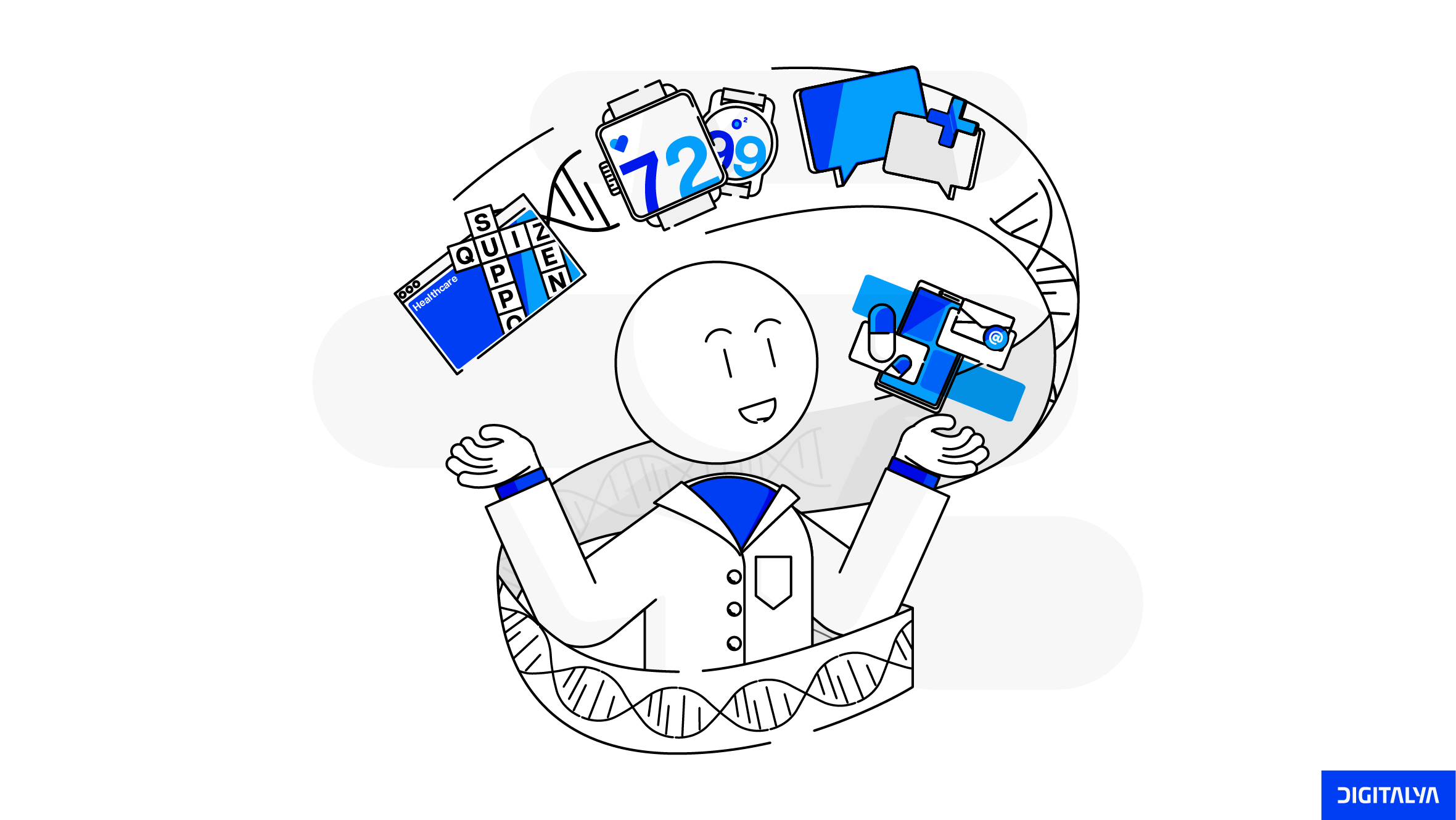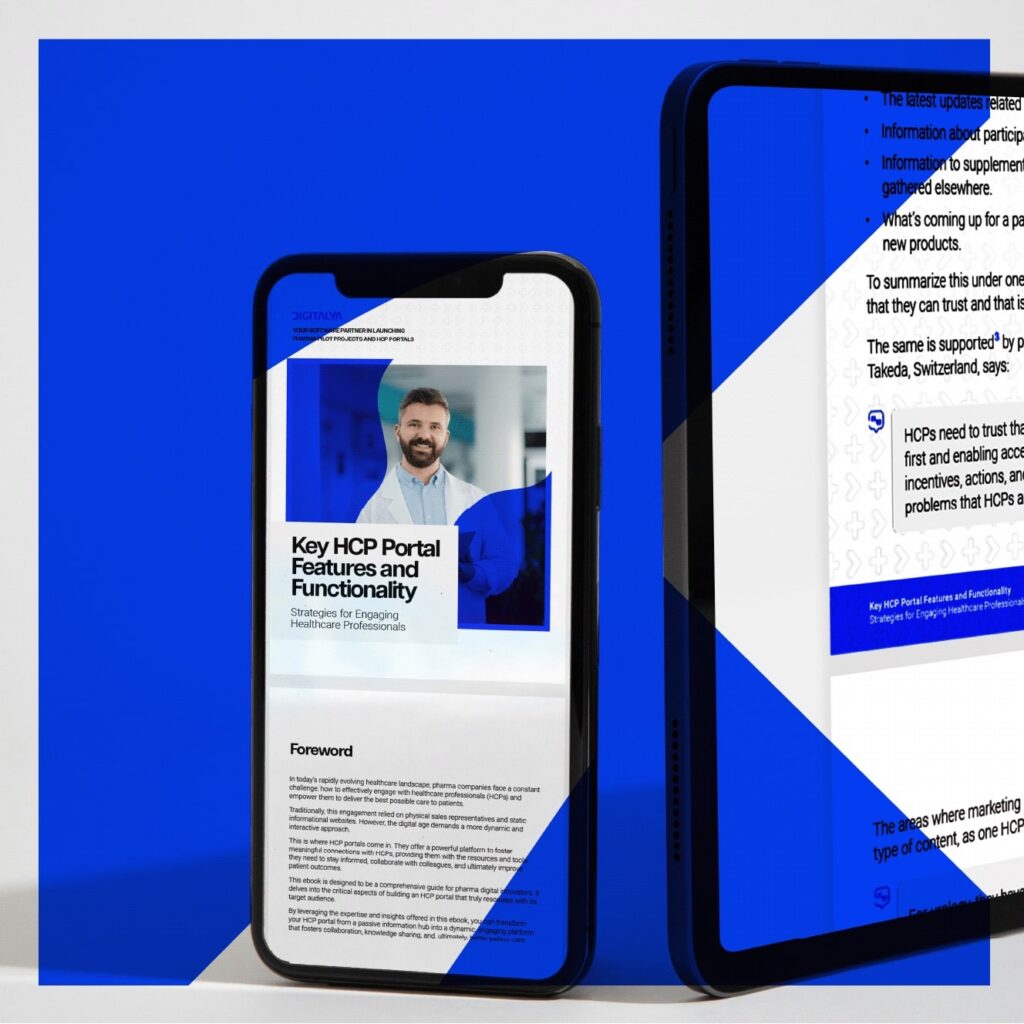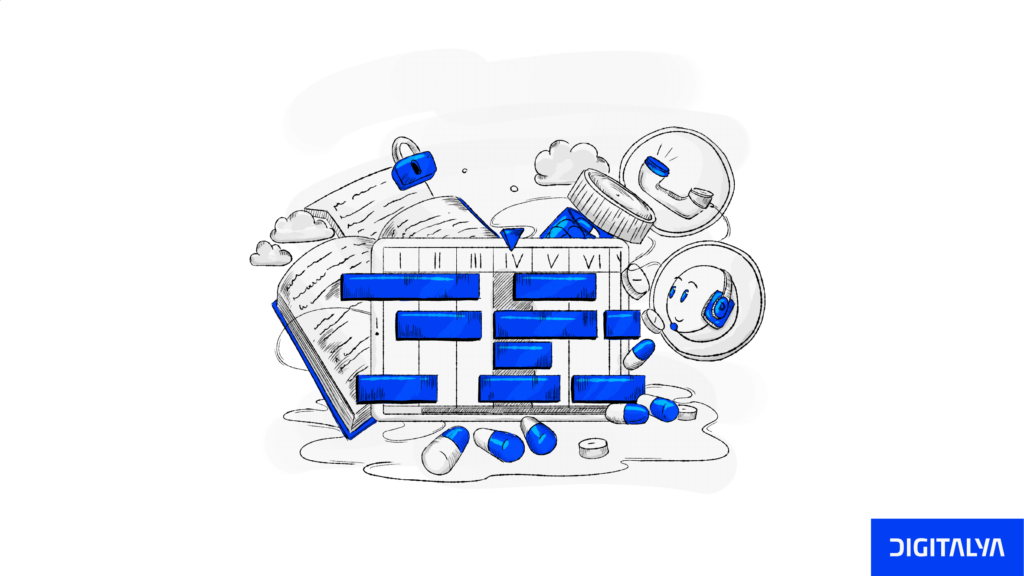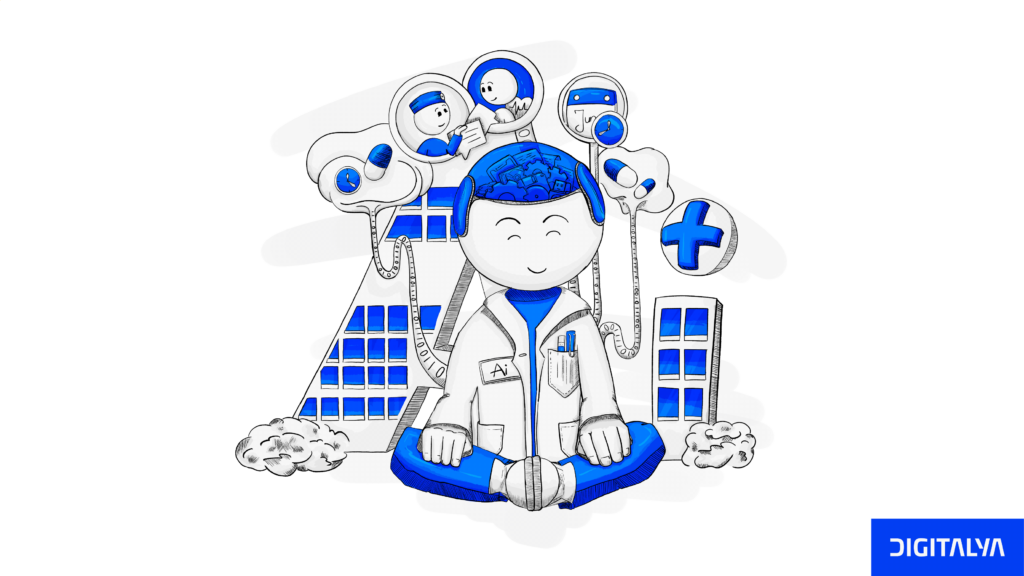1. What are pharma digital companions?
First things first. What are these newly emerged companions? They do sound like a high-tech pet or the sort of robot friend that keeps you company and does some chores around the house. Generally speaking, that is the concept: a tech solution, often AI-powered and reproducing human interaction, that accompanies healthcare professionals and patients alike, helping them deal with various diagnoses and affections.
Put more clearly, pharma digital companions refer to digital tools, healthcare apps, or platforms designed to support and engage patients and HCPs throughout their treatment journey. The companions serve as virtual allies, providing personalized assistance, information, and support tailored to the individual needs of patients.
Whether it’s tracking symptoms, offering educational resources, facilitating telehealth consultations, or monitoring treatment progress, digital companions play a pivotal role in augmenting patient care and improving health outcomes.
2. The growing significance of digital companions in healthcare
In recent years, the significance of digital companions in healthcare has surged, driven by the increasing demand for personalized and accessible patient support. A report by Global Data on Mobile Health Apps shows that, by 2030, the market for regulated medical apps is expected to reach US$12.1 billion.
Moreover, according to Deloitte, in 2022, disease management apps were worth USD 8.7 billion on the global market, with a projected annual growth of 12.3% from 2023 to 2030.
These companions offer a myriad of benefits, ranging from enhancing patient engagement and adherence to gathering real-world data for insights and improved outcomes. As the healthcare landscape continues to evolve, digital companions are poised to play an even more integral role in patient care and management.
3. Benefits of pharma digital companions
Digital transformation in pharma would not take place, evidently, if there weren’t clear benefits for all the categories involved: patients, healthcare professionals, health organizations, and pharma companies. So, let’s take a look at what the main benefits are:
3.1 Enhancing patient engagement and adherence
One of the main concerns for physicians worldwide and a key factor in failing to obtain the expected health outcomes is patients’ inconsistency in following the prescribed treatment. Thus, the primary benefit of pharma digital companions is their ability to foster greater patient engagement and medication management.
By providing personalized support and resources, patients engage more and take an active role in managing their health, leading to improved compliance and better health outcomes.
3.2 Improving treatment outcomes and patient health
Digital solutions such as patient companion apps enable continuous monitoring and support, allowing the healthcare professional to track patient progress in real-time and intervene when necessary. This proactive approach not only improves treatment outcomes but also enhances patient health by ensuring timely interventions and adjustments to care plans.
3.3 Gathering valuable real-world data
Another significant advantage of digital companion apps is their ability to gather valuable real-world data. By tracking patient interactions, symptoms, and treatment responses, these digital health solutions provide valuable insights into patient behavior, preferences, and treatment efficacy, which can inform future decision-making and product development.
3.4 Expanding patient education and support
Digital companion apps serve as a valuable resource not only for patient support but also for keeping HCPs up to date with the latest medical developments.
Regarding patients’ benefits, they can offer access to a wealth of information, resources, and tools to help them understand their condition and treatment options. By providing personalized education and support, these companions empower patients to make informed decisions about their health and treatment.
3.5 Reducing healthcare costs
Because pharma digital companions engage patients in following their treatment and monitoring their health, the result is increasing adherence to treatment and proactive management of health conditions.
Thus, they can potentially reduce healthcare costs associated with hospitalizations, emergency room visits, and complications. By maintaining medication adherence and keeping patients better informed, these companions help to minimize the burden on healthcare systems and resources.
4. Types of pharma digital companions
Pharma digital companions come in various forms, each serving specific purposes and catering to different aspects of patient care and management. Some key trends in the health industry regarding digital companions are:
4.1 Informational and educational companions
A digital patient companion provides access to educational resources, information about their condition, treatment options, and lifestyle recommendations.
On the healthcare professional side, educational companions capture value by bringing much-needed information on the specific topics that interest each HCP. Mind that their spare time is very limited, and they focus on getting maximum quality insight from every second.
At the same time, they are perfectly aware of the marketing strategies behind any pharma company’s approach. Thus, HCPs can become suspicious and even reluctant to interact with push content sent by email or other digital technologies. Pharma digital companions can strengthen the trust between HCPs and your health company by acting as a supportive presence, ready to offer relevant content without any “sales” scheme in a human-like interaction.
4.2 Symptom tracking and management companions
These companions enable patients to track symptoms, medication adherence, and other vital health metrics, providing valuable insights into their condition and treatment progress.
IoT in healthcare develops quickly with remarkable results. Digital therapeutics paired with medical and medication devices gather health data, run symptom analyses, and can alert doctors when necessary about a patient’s state of health.
Timely measures can prevent problems from getting worse. Digital drug companions can help with dosage calculations. This way, patients with memory issues (or just light-mindedness) are sure to get the correct measured values for their prescription drug and follow the right treatment.
Let’s not forget the patients with chronic diseases. In the United States, there are approximately 147 million people living with chronic conditions. Extrapolate that number to the entire world, and you’ll get an idea of how much such a digital solution is needed. It is, in fact, a public health issue.
Pharma digital companions can help these patients rigorously follow their life-long treatment plans. By tracking behavior, they can offer personalized feedback and help patients maintain care activities that can improve health outcomes. Diabetes is a condition for which digital health tools are largely implemented, starting with automatic blood sugar measurements and alerts on a mobile app.
4.3 Telehealth and remote monitoring companions
These companions facilitate virtual consultations, remote monitoring of patient health metrics, and communication between patients and healthcare providers, enabling timely interventions and adjustments to care plans.
Telemedicine has gained much terrain in the past 4 years and constantly proves its efficiency. By using such companions, patients become digital patients that HCPs can monitor and communicate with remotely.
For routine checks and follow-ups, these pharma digital companions build a virtual bridge between doctor or nurse and patient, without the need for physical presence and all the inconvenience that comes with it. All those involved gain precious time, save money (if travel costs are involved), and get answers fast enough to prevent a condition from worsening.
5. Developing and implementing effective pharma digital companions
All things nice, but how do you actually put such a digital companion on the market? As many things in life that seem complicated, with proper planning and the right people and set of skills, medical app development becomes a fine possibility. That is not to say it’s easy because the development and implementation of pharma digital companions require careful planning, design, and execution. Take into account these key considerations:
5.1 User-centered design and patient involvement
User experience, whether we talk about patient experience or HCPs as users, is paramount. To ensure the effectiveness and usability of digital companions, it’s essential to involve the end user in the design process and prioritize user-centered design principles, such as the patient journey. The more intuitive and closer to human interaction it is, the better the clients will react, generating improved outcomes.
5.2 Clear and personalized communication
Digital companions should communicate information clearly and personalized, taking into account the individual needs and preferences of patients and HCPs. We are bombarded by information all day (even in our sleep sometimes).
Promotional and irrelevant messages account for most of this enormous brain load. No one wants another app that adds to the information they already receive. However, if you respect their mental space and real needs, you’ll win the users’ appreciation and loyalty.
That is not to say you shouldn’t apply marketing strategies to gain market access, but it should deliver customized messages that address relevant needs. AI in pharma marketing has come a long way, and it is the answer to craft personalized approaches that offer answers instead of burdens.
5.3 Integration with existing healthcare systems
Digital companions should seamlessly integrate with existing healthcare systems and workflows to ensure smooth implementation and adoption by healthcare providers. The healthcare ecosystem is complex, but everything works better when connection and collaboration are enabled.
Integration between pharma digital companions and healthcare systems will first and foremost improve patient outcomes, the general state of health, and the health economy. Secondly, but equally important, the overall approach will help medical and healthcare staff act more fluently, reducing unnecessary waste of time, frustration, and fatigue.
5.4 Data security and privacy
Protecting patient data is crucial. Digital transformation in pharma companies should adhere to strict data security and privacy standards to safeguard patient information and comply with regulatory requirements. Analyst reports on patient populations are important for developing medicine and innovative treatments. Still, the way they are obtained should be ethical, and the privacy rights of individuals should be respected.
5.5 Evidence-based design and evaluation
Needless to say, the design and efficacy of digital companions should be based on scientific evidence and undergo rigorous evaluation to ensure their effectiveness in improving patient outcomes and engagement. When dealing with people’s health, nothing should be left to hazard.
6. Case studies of successful pharma digital companions
6.1 Examples of companions that have improved patient outcomes and engagement
In 2020, Sanofi partnered with Taiwanese company Health2Sync to provide integrated, digitized diabetes management by developing patient management software for healthcare professionals, as well as a mobile app for patients. This digital health partnership led to implementing the diabetes digital companion in clinics and hospitals contracted by Sanofi. In May 2022, over 10000 insulin patients and more than 200 clinics had onboarded the digital companion program. The app resulted in improved glycemic control and increased patient adherence to treatment plans.
The utility of this approach becomes clear given that a 2019 report published by the Taiwan Association of Diabetes Educators in the Diabetes Atlas regarding the Taiwan population showed that less than 40% of diabetes patients can reach HbA1c <7%. The rate of insulin administration in Taiwan is 12%, a low number compared with Europe and the USA. Moreover, in Taiwan alone, there are over 2.2 million diabetes patients.
6.2 Insights from pharma companies that have effectively implemented digital companions
Pfizer is a good example of a pharma company that successfully implements digital companions. In 2019, they launched the Mabu wellness coach, which is a patient engagement robot that functions on artificial intelligence (AI), built by Catalia Health.
The Mabu patient companion “talks” with patients, asks them how they feel, and answers their questions about the treatment. The companion is linked to an Insights Platform that sends valuable information to clinicians, so the caregivers can intervene in time to support the patient’s specific needs in their treatment journey and manage symptoms in real time.
Pfizer also acquired ResApp Health for $75 million, in their pursuit to diagnose and manage respiratory diseases using AI technology. The market data shows that the company’s revenues rocketed by 3503% in 2022 compared to 2020.
For patients living with cancer, Pfizer developed the LivingWith™ app – yet another digital patient companion. It connects patients with an oncology support system. It helps them remember and keep important information received from their doctors and also share relevant information with caregivers, family, and friends.
7. Future of pharma digital companions
As digital technologies continue to advance and pharmaceutical companies invest massively in digital, the future of pharmaceutical digital companions looks promising.
7.1 Emerging trends in digital companion technology
Advancements in AI, machine learning, and natural language processing enable more personalized and adaptive digital companions. They become capable of learning from patient interactions and adapting their recommendations over time to match precise needs in real-time, whether it is detecting symptoms, adapting treatment dosage, answering questions, or even providing psychological support.
7.2 Potential applications of artificial intelligence and machine learning
When used by a large enough population of patients, such AI-powered digital companions can use data to build predictive models for health outcomes. They can identify potential complications early on and recommend personalized interventions to prevent adverse events. Imagine that in the near future, with the help of digital companion apps, patients can access patient support programs and digital therapy from the safety of their homes quickly and easily.
7.3 The role of digital companions in the precision medicine era
We have entered the era of precision medicine. It is with the help of digital companions and data analytics that clinicians and pharma companies will be able to tailor treatments and interventions to the individual needs and genetic makeup of patients, enabling more targeted and effective healthcare delivery.
8. Conclusion
It is safe to say that pharma digital companions represent a paradigm shift in patient care and medication management, even in public health. They offer personalized support, education, and engagement all in one throughout the patient journey.
By leveraging the potential of digital technologies, pharmaceutical companies can empower patients, improve treatment outcomes, and finally drive better health outcomes. As we continue to embrace innovation and advance digital companion technology, the future of healthcare looks brighter than ever before.






